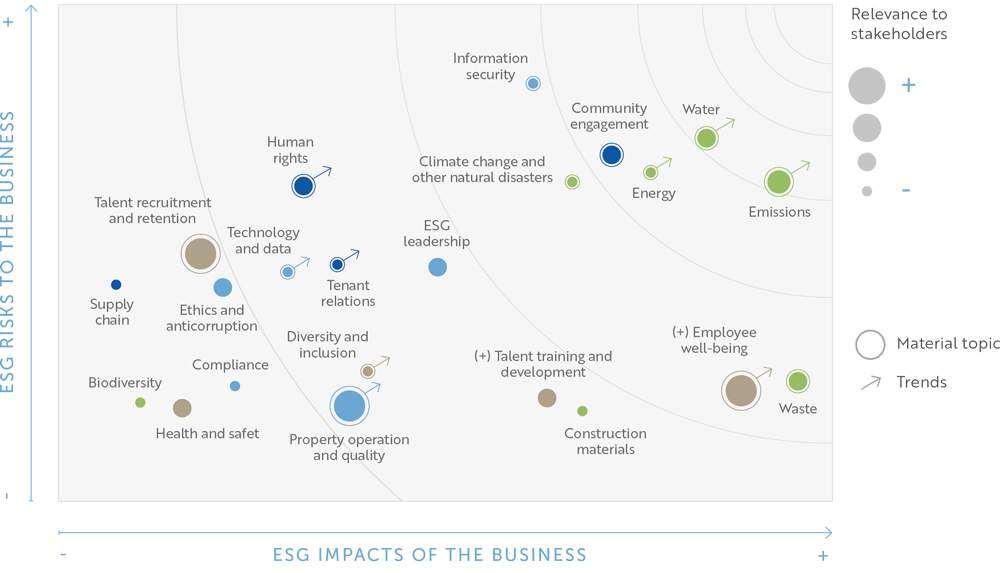3-1, 3-2
Materiality
We have a policy of updating our materiality analysis every two years, so we carried out this update in 2023. This year, the study incorporated a dual materiality approach, to analyze how our activities impact the surroundings—both environmentally and socially—but also how changes in the environment and society affect the company’s financial performance.
By considering both external and internal impacts, we can obtain a complete and balanced view of sustainability and the relevant issues to be addressed. Thus, appropriate strategies can be put in place and informed decisions can be made to address the challenges and take advantage of the opportunities related to sustainability.
This year, the update to our materiality analysis incorporated the impact of our operations on the environment and the impact of the environment on our business strategy: a double materiality approach.
Dual materiality matrix

Environmental
Governance
Human Capital
External social
Material topics
Emissions
Water
Energy
Community engagement
Climate change and other natural disasters
Information security
Waste
Employee well-being
Human rights
Talent recruitment and retention
Property operation and quality
Latent topics
ESG leadership
Talent training and development
Construction materials
Diversity and inclusion
Technology and data
Tenant relations
Emerging topics
Ethics and anticorruption
Supply chain
Compliance
Health and safety
Biodiversity
Material issues
These pose a high level of risk to the business and a high level of potential impact on the environment, but they also have a significant influence on the organization’s ability to create long-term value, and therefore require priority attention and strategic management.
Latent issues
These imply certain degree of risk to the business and/or a varying level of impact on the environment. These issues have not yet reached their full risk or impact potential, but could become material in the future due to changes in the environment or business operations.
Emerging issues
These issues currently present a low level of risk to the business, but have the potential to have a significant impact on the environment in the future. These issues may represent opportunities for innovation and strategic differentiation.
3-1, 3-2, 3-3
The methodological approach we took for our double materiality analysis was as follows:
- Determine the scope and define the goal. Identify and prioritize ESG topics that may pose a risk to the organization and which are relevant to stakeholders.
- Analyze the organizational context. Based on a review of news media, internal information, standards, reference frameworks and investor requests, analyze industry trends and identify stakeholders.
- Evaluate ESG impacts and risks. Approach stakeholders and apply tools to learn about their opinions.
- Prioritize the topics. Based on the responses to our inquiries, cross-reference priority topics for stakeholders with the results of ESG risks and impacts and draw up the materiality matrix.
- Recommendations and project portfolio. To determine maturity in ESG topics, select issues for project development and hold workshops to co-create and co-design solutions based on materiality.
| MATERIAL TOPIC | JUSTIFICATION OF IMPACT RELEVANCE | STAKEHOLDERS DIRECTLY AFFECTED | TYPE OF IMPACT | SEE STRATEGY |
|---|---|---|---|---|
| Emissions | Impact on climate change through the generation of greenhouse gas emissions. | Direct community | Real negative | p. 58 |
| Water | Use of potable water for the proper maintenance and operation of the buildings, which generates pressure on bodies of water through exploitation or dumping, causing degradation of water quality. | Direct and indirect community | Real negative | pp. 48 and 49 |
| Energy | Energy consumption from non-renewable sources, which has an impact on climate change. | Direct and indirect community | Real negative | pp. 46 and 47 |
| Community engagement | The infrastructure projects of the FIBRA cause changes in the life of communities, so a close relationship with the community is necessary to reach mutually beneficial agreements. The lack of engagement mechanisms may compromise community well-being. | Direct community | Real negative | pp. 62-66 |
| Climate change and other natural disasters | Effects on the physical and mental integrity of employees, visitors and tenants when operating properties in areas subject to high seismic risk and various atmospheric phenomena. | Visitors Community Tenants Investors Employees Suppliers |
Potentially negative | pp. 52-58 |
| Information security | The organization handles personal information of various stakeholders—visitors, employees, suppliers, tenants, and others—which requires adequate controls to protect personal information and safeguard data integrity. The main risks are found in the handling of employee information and in controlling visitor access to the properties. | Visitors Employees Suppliers Tenants |
Real negative | p. 41 |
| Waste | The organization generates solid urban, special handling and hazardous waste, which increases pressure on sanitary landfills or open dumps, generating greenhouse gas emissions. | Direct community Communities near disposal areas |
Real negative | p. 50 |
| Employee well-being | We promote practices to appropriately distribute workloads without forcing employees to work overtime, in addition to other practices that promote employee well-being. | Employees | Real positive | pp. 69-71 |
| Human rights | Fibra Danhos’ activities have an impact on the lives of people living near the properties. This coupled with a lack of regulatory compliance controls, supervision and transparency could compromise respect for human rights. | Visitors Community Tenants Employees Suppliers |
Potentially negative | pp. 65-66 |
| Talent recruitment and retention | The ability to recruit and retain talent directly influences our productivity, innovation, reputation, costs and ability to meet its challenges. High turnover could compromise sustainable growth and the preservation of a strong corporate culture. | Employees | Potentially negative | pp. 69-71 |
| Property operation and quality | Properties require maintenance to preserve their structural integrity, prevent deterioration due to factors such as weather, and ensure that internal facilities such as electrical and plumbing systems are functioning properly so as not to compromise the safety of tenants, employees or visitors. | Tenants Employees Visitors |
Potentially negative | p. 74 |